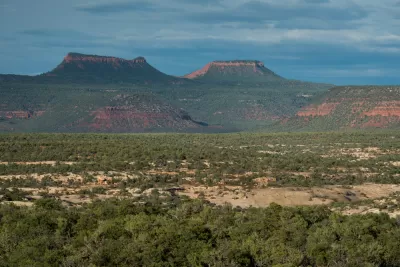President Trump has weakened protections for 35 million acres of public land, despite repeating his intentions to surpass the model for conservation set by President Teddy Roosevelt.

Throughout his time in office, surrogates for the president have proclaimed Trump's desire to surpass the model of Teddy Roosevelt for conservation, according to an article by Chris D’Angelo. Critics, however, say that the Trump administration has fallen far short of that example, and now there's data to back up that critique.
A new analysis from the Center for American Progress, detailed in a separate article by Jenny Rowland-Shea and Zainab Mirza says President Trump has, in fact, thrown the presidency's bipartisan history of expansion of public lands. "President Trump is the only president in U.S. history to have removed more public lands than he protected," according to that article.
The Center for American Progress calculates that over the past three years, the Trump administration has attempted to remove protections from nearly 35 million acres of public lands—approximately 1,000 times more land than his administration has protected. While the courts may overturn many of the Trump administration’s rollbacks, these actions equate to stripping protections from an area the size of Florida.
The article provides details of the scope of the Trump administration's anti-conservation efforts, all designed for the purpose, according to Rowland-She and Mirza, of giving the fossil fuel industry "unfettered access to public lands and waters."
FULL STORY: The Most Anti-Nature President in U.S. History

Alabama: Trump Terminates Settlements for Black Communities Harmed By Raw Sewage
Trump deemed the landmark civil rights agreement “illegal DEI and environmental justice policy.”

Planetizen Federal Action Tracker
A weekly monitor of how Trump’s orders and actions are impacting planners and planning in America.

The 120 Year Old Tiny Home Villages That Sheltered San Francisco’s Earthquake Refugees
More than a century ago, San Francisco mobilized to house thousands of residents displaced by the 1906 earthquake. Could their strategy offer a model for the present?

In Both Crashes and Crime, Public Transportation is Far Safer than Driving
Contrary to popular assumptions, public transportation has far lower crash and crime rates than automobile travel. For safer communities, improve and encourage transit travel.

Report: Zoning Reforms Should Complement Nashville’s Ambitious Transit Plan
Without reform, restrictive zoning codes will limit the impact of the city’s planned transit expansion and could exclude some of the residents who depend on transit the most.

Judge Orders Release of Frozen IRA, IIJA Funding
The decision is a victory for environmental groups who charged that freezing funds for critical infrastructure and disaster response programs caused “real and irreparable harm” to communities.
Urban Design for Planners 1: Software Tools
This six-course series explores essential urban design concepts using open source software and equips planners with the tools they need to participate fully in the urban design process.
Planning for Universal Design
Learn the tools for implementing Universal Design in planning regulations.
Clanton & Associates, Inc.
Jessamine County Fiscal Court
Institute for Housing and Urban Development Studies (IHS)
City of Grandview
Harvard GSD Executive Education
Toledo-Lucas County Plan Commissions
Salt Lake City
NYU Wagner Graduate School of Public Service





























